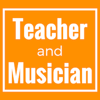SoW overviews
Last week, I wrote about planning a scheme of work for music by looking at the values, structure and design tenets that you want to embed in the process. Taking the time to do this really does help to ensure that the lessons you end up teaching align with the values you hold for musical learning in your school. Today, we will look at creating an overview document to map out the musical learning before you get to the nitty gritty of writing unit plans.
Again, there’s a downloadable resource to go with this blog post. The text below explains each part of the template and the document can be downloaded by clicking the link at the bottom of the page.
Thinking in key stages
As mentioned in last week’s blog post, it makes sense to see your scheme of work as covering an entire key stage rather than just a year group at a time. This way, you can ensure that you are planning for a continuing ‘musical journey’ rather than a series of vaguely connected units. One thing that I found helping with this was to ensure that unit numbers were continuous over the key stage rather than following the line of:
- Year 7, Unit 1
- Year 8, Unit 1
- Year 9, Unit 1
Assuming that you have six units in a year (and there’s absolutely no reason why that should be the case), then the above units would be:
- Unit 1
- Unit 7
- Unit 13
It’s a small point but it can certainly help with seeing continuity and thinking about how (or if) each unit should flow into the next.
‘Main approach’
I find it useful to see each year group as having a specific goal within the larger context of the scheme of work. For a Key Stage 3 scheme of work, I want learners to be comfortable as independent musicians by the end of Year 9. As a result, I would typically design a SoW around a different approach each year, all leading towards that specific goal. Drawing heavily from
Musical Futures, I would usually define that journey as:
- Year 7: skills acquisition
- Year 8: classroom workshopping
- Year 9: informal learning
The skills acquisition in Year 7 gives them the ability to do the classroom workshopping, which then gives them the ability to take more responsibility for their musical learning through informal learning.
The later units in Year 7 will incorporate more and more workshopping style lessons to facilitate this. Equally, the later units in Year 8 will gradually move towards informal learning. Having a ‘main approach’ for the year group doesn’t have to detract from the ‘whole key stage’ view mentioned above. In fact, it should facilitate it.
Repertoire
I started adding a ‘repertoire’ box to all my SoW and unit plans quite early on. Mentioning style/genre on the SoW overview can help but actually seeing the repertoire on this ‘bird’s eye view’ can make it easier to spot any potential issues. For example, is it a problem if all the pieces learned in Year 8 are in D Major? Is it an issue with all the repertoire in Year 7 is typically associated with male musicians? The list of pieces to be played makes this so easy to spot.
Of course, you won’t be able to name this for every unit straightaway. You may need to identify repertoire for some units as:
- student compositions
- co-constructed through improvisation
- student choice
Title and objectives
These two are pretty self-explanatory. A title for the unit and what your objective is for it. It helps to avoid buzzwords and jargon in the objective. Keep it simple and musical so that you can see exactly how it fits into your
values, structure and design tenets.
A resource for you
As promised, here’s a really simple template for you to use when planning your music scheme of work in this manner. You
can download the resource by clicking here.

